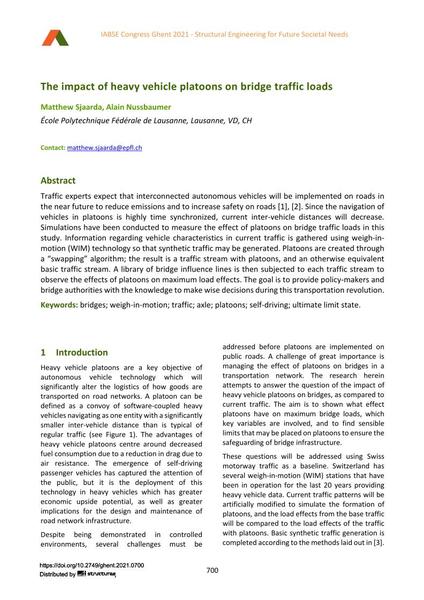The impact of heavy vehicle platoons on bridge traffic loads

|
|
|||||||||||
Détails bibliographiques
| Auteur(s): |
Matthew Sjaarda
(École Polytechnique Fédérale de Lausanne, Lausanne, VD, CH)
Alain Nussbaumer |
||||
|---|---|---|---|---|---|
| Médium: | papier de conférence | ||||
| Langue(s): | anglais | ||||
| Conférence: | IABSE Congress: Structural Engineering for Future Societal Needs, Ghent, Belgium, 22-24 September 2021 | ||||
| Publié dans: | IABSE Congress Ghent 2021 | ||||
|
|||||
| Page(s): | 700-708 | ||||
| Nombre total de pages (du PDF): | 9 | ||||
| DOI: | 10.2749/ghent.2021.0700 | ||||
| Abstrait: |
Traffic experts expect that interconnected autonomous vehicles will be implemented on roads in the near future to reduce emissions and to increase safety on roads [1], [2]. Since the navigation of vehicles in platoons is highly time synchronized, current inter-vehicle distances will decrease. Simulations have been conducted to measure the effect of platoons on bridge traffic loads in this study. Information regarding vehicle characteristics in current traffic is gathered using weigh-in- motion (WIM) technology so that synthetic traffic may be generated. Platoons are created through a “swapping” algorithm; the result is a traffic stream with platoons, and an otherwise equivalent basic traffic stream. A library of bridge influence lines is then subjected to each traffic stream to observe the effects of platoons on maximum load effects. The goal is to provide policy-makers and bridge authorities with the knowledge to make wise decisions during this transportation revolution. |
||||
| Mots-clé: |
ponts
|
||||
| Copyright: | © 2021 International Association for Bridge and Structural Engineering (IABSE) | ||||
| License: | Cette oeuvre ne peut être utilisée sans la permission de l'auteur ou détenteur des droits. |
||||
